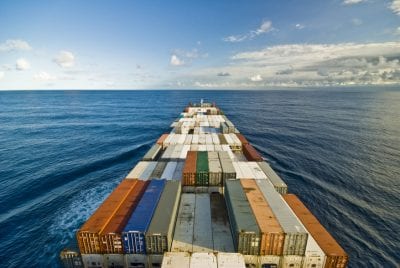Almost 90% of goods and food worldwide are transported through international ocean freight shipping, forming a crucial part of the global supply chain. Ocean freight shipping companies enable manufacturers and suppliers to move massive amounts of cargo across vast distances, connecting different continents through efficient logistics services.
10 Interesting Facts about Ocean Freight Shipping

Whether you’re importing electronics, clothing, vehicles, or raw materials, ocean freight shipping plays a fundamental role in supporting international commerce. Let’s dive into ten fascinating facts about ocean freight and why it remains essential today.
1. Goods Are Transported in Standardized Shipping Containers
All goods in ocean container shipping are transported in standardized sea containers, typically 20 or 40 feet in length. These container types streamline the logistics process, from loading to unloading, making international shipping faster and more cost-efficient. Even specialized cargo such as hazardous materials follows strict containerization standards to ensure safety and regulatory compliance.
Fun fact: Innovations like refrigerated containers (reefers) allow perishable items like fruits and pharmaceuticals to travel across oceans without spoilage.
2. Ocean Freight Shipping is Extremely Cost-Effective
While air freight is much faster, ocean transportation is significantly cheaper for moving large volumes of goods. For example, the international ocean freight shipping rates for a 200 kg shipment may be almost the same as for a 2000 kg shipment — making bulk shipping through oceans the go-to solution for businesses.
In 2024, according to the latest ocean freight container shipping rates chart, container shipping rates are stabilizing after pandemic-induced volatility, making sea shipping an attractive option for cost-conscious shippers.
3. Different Types of Ocean Freight Shipping Exist
Not all ocean freight is the same. Shippers can choose between different types of ocean freight shipping based on their cargo size and urgency:
-
FCL (Full Container Load): One shipper uses the entire container.
-
LCL (Less-than-Container Load): Multiple shippers share a container.
-
RORO (Roll-on/Roll-off): For vehicles and machinery that roll on and off the ship.
-
Bulk Cargo Shipping: Non-containerized goods like grain, coal, or liquids.
Choosing the right method impacts your shipping cost, transit time, and delivery flexibility.
4. Mega Vessels Are Engineering Marvels
The largest ocean vessels can transport over 18,000 TEUs (twenty-foot equivalent units) — that’s about 745 million bananas! To put that into perspective, a single ship could provide every European citizen with a banana and still have surplus left.
These vessels symbolize the immense scale of international ocean freight shipping and the industry’s commitment to maximizing efficiency and reducing carbon emissions per unit of cargo.
5. Ocean Freight is Among the Greenest Shipping Methods
An ocean vessel traveling from China to France emits less CO₂ per ton-mile than a truck traveling from Houston to Oklahoma City. Among all long-distance transportation options, ocean freight shipping companies offer one of the most sustainable solutions, especially when goods are consolidated into large shipments.
Environmental regulations like IMO 2020, which reduced sulfur emissions from ships, further push the industry towards cleaner operations.
6. Piracy Remains a Modern-Day Threat
Despite advances in navigation and security, piracy remains a risk for international ocean freight shipping companies. Every day, about two ships are hijacked somewhere in the world, with hotspots like the Gulf of Aden near Somalia posing major threats.
Shipping companies invest heavily in private security, vessel hardening, and route planning to mitigate risks.
7. A Male-Dominated Industry with Global Reach
The ocean shipping industry remains highly male-dominated, with about 98% of seafarers being men. Interestingly, about one-third of all seafarers are from the Philippines, emphasizing the critical role developing nations play in supporting global trade through maritime labor.
Diversity efforts are slowly gaining traction, with more opportunities being created for women at sea.
8. The World Fleet is Massive and Varied
There are approximately 55,000 commercial ships traversing the world’s oceans at any given moment. These vessels are operated by thousands of different ocean freight shipping companies and range from small feeder ships to ultra-large container vessels (ULCVs).
Ownership concentration is notable too — countries like Germany, Japan, and Greece dominate the global fleet, with Greece’s private shipping sector holding a significant share of the world’s tonnage.
9. Not All Vessels Have Communication Access
Shockingly, around 33% of ocean vessels lack constant communication capabilities while at sea. Limited internet access can complicate real-time cargo tracking, which is increasingly demanded by global supply chains and customers alike.
Advances in satellite communications and IoT-based ship monitoring are gradually addressing this gap.
10. Complex Logistics Beyond the Port
Shipping a container across the ocean is only part of the journey. Once cargo arrives at port, companies must handle customs clearance, inland transportation, and delivery coordination.
Choosing the right international ocean freight shipping companies can dramatically simplify this process. Reputable providers offer end-to-end services — from port-to-door delivery to declared value coverage for valuable goods — ensuring a seamless experience.
Ocean freight shipping is far more than just moving goods across oceans — it’s a complex, evolving system that supports the backbone of international trade. Understanding the different types of ocean freight shipping, keeping up with container shipping rates, and working with trusted international ocean freight shipping companies can make a significant difference in how efficiently and cost-effectively businesses operate. As global commerce continues to expand, ocean freight will remain a reliable, sustainable, and strategic option for moving goods around the world.
Learn more about ocean shipping in Ocean Shipping: Let’s Talk LCL
